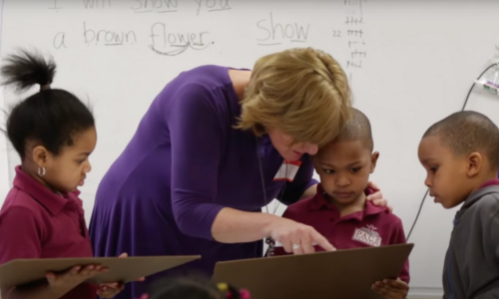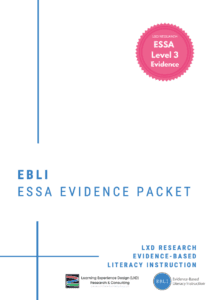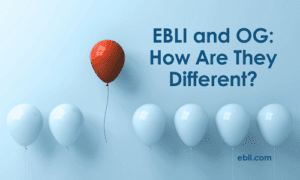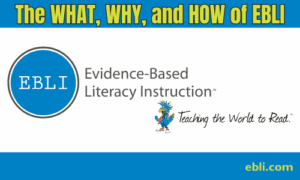Nora Chahbazi, EBLI Founder with Dr. Rachel Schechter, LXD Research Founder
In the quest for effective literacy instruction, Nora Chahbazi, a neonatal nurse turned literacy advocate, discovered a groundbreaking approach that challenges traditional phonics programs. As a mother helping her own daughter learn to read, Nora realized the power of a speech-first approach. Within just three hours, she successfully taught her daughter how to read. This experience led her to recognize the struggles faced by countless parents and the need for intervention in teaching teachers how to support all students’ reading development. Nora immersed herself in the world of literacy, becoming an expert in phonics programs and establishing her own reading center. Through partnerships with many school districts, Nora and her team brought much-needed teacher training, support, and effective, efficient research-aligned practices to enhance reading, spelling, and writing instruction. Growing evidence (Petscher et al., 2020) suggests that linguistic phonics, which is employed by EBLI, is faster than traditional programs in developing students’ phonemic awareness, letter-sound knowledge, decoding skills, and ultimately improving reading comprehension.
Review our ESSA Evidence Packet created by our research partner, Learning Experience Design (LXD) Research, which presents our research-base and ESSA Level 3 Research Study.
How is EBLI different from other phonics programs?
EBLI’s revolutionary approach challenges the limitations of traditional phonics programs (Moats, 1998) and offers a comprehensive solution to bridge gaps and enhance reading skills. By focusing on structured linguistic literacy instruction, EBLI empowers teachers to deliver engaging and interactive lessons that propel students to higher literacy proficiency. The program not only frees up valuable planning and instructional time for teachers but also integrates professional development for educators directly into the EBLI lessons . This unique approach ensures that teachers have the necessary tools and knowledge to implement evidence-based instruction effectively. Studies indicate that coaching-based professional development can enhance teachers’ self-confidence, crucial for effective literacy instruction (Varghese et al., 2016). The online course is enhanced and revised yearly based on the feedback received from educators and others who have used the EBLI training and student lessons.
How does EBLI help students learn how to read?
By employing a speech-first approach to literacy instruction, EBLI provides effective mechanisms for struggling readers to decode and comprehend any text. Traditional phonics instruction typically relies on rote memorization of various rules, but empirical studies have shown that knowing those rules does not necessarily lead to improvement in students’ reading abilities (Carmen, 2006; Duncan, 1998; Endress, 2007). By contrast, research indicates that the speech-to-print approach, which includes encoding activities to decode like those found in EBLI, has been shown to yield better results (Weiser & Mathes, 2011). Moreover, the speech-to-print approach fosters a more comprehensive understanding of the English system. By explicitly teaching the five essential components of reading as well as handwriting, spelling, and writing, EBLI equips teachers with the necessary tools to guide students’ literacy development (National Reading Panel, 2000). Online training, along with ongoing coaching embedded into the student lessons, are provided extensively by EBLI. These facets support teachers in delivering targeted instruction, correcting student errors, and implementing research-backed strategies, ensuring that all students receive the instruction and support they need to become proficient readers, writers, and spellers.
How does EBLI work? Is EBLI research-based?
EBLI incorporates several key research-based strategies that are fundamental to the success of its approach. One such strategy is guiding teachers how to provide timely feedback to teachers, which has been shown to significantly improve instructional practices. Research indicates that brief, stand-alone teacher trainings are unlikely to result in substantial improvements (Yoon et al., 2007). In contrast, professional learning opportunities that offer ongoing support, distributed practice, and feedback are more effective in enhancing reading instruction and student literacy performance (Dunlosky et al., 2013). EBLI integrates feedback into its training through modeling, monthly coaching calls, and additional support systems for teachers.
Providing brief instruction steps is another research-backed (Rosenshine, 2012) learning strategy employed by EBLI. The team at EBLI provides teachers with “how-to” steps for different error correction scenarios, ensuring they have a clear understanding of effective practices when teaching students how to read. By guiding teachers on what to do and what not to do during instruction, EBLI helps them refine their teaching techniques and improve student outcomes. Research (Brown, Roediger, McDaniel, 2014) says that it is important to not only teach what to do but what not to do to gain effective learning outcomes.
What is EBLI’s unique process to model instruction for teachers and students?
Another important research-based strategy employed by EBLI is modeling for both teachers and students. Research has shown that observing expert models in authentic classroom settings can significantly impact instructional practices and student learning (Vernon-Feagans, Kainz, Amendum, Ginsberg, Wood, & Bock, 2012). After providing a full-day asynchronous orientation to equip educators with theoretical knowledge and background information, teachers have the opportunity
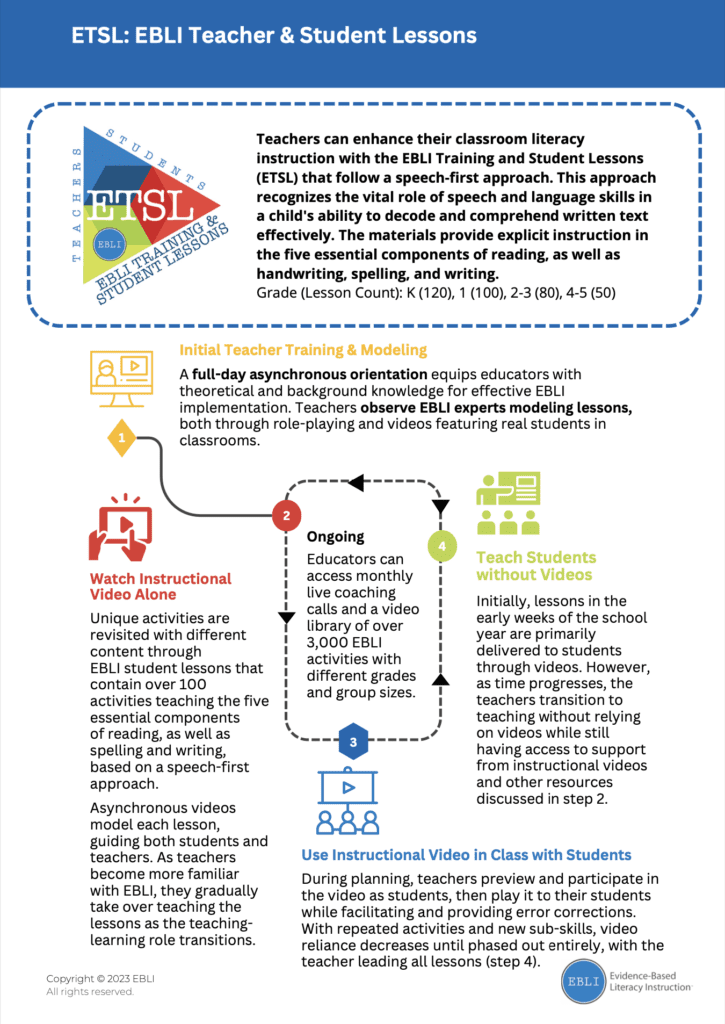
to observe EBLI experts through role-playing and videos featuring real students in classrooms. This modeling component allows teachers to witness the EBLI instructional techniques in action, providing them with tangible examples (and non-examples) to apply in their own classrooms. Teacher modeling is also an integral component of EBLI student instruction by utilizing video instruction directly to students, with teachers facilitating, especially whenever a new activity or strategy is introduced.
How does EBLI serve students who have continued to fail with traditional phonics instruction?
EBLI’s transformative approach to literacy instruction empowers teachers and students alike. By challenging the limitations of traditional phonics programs, EBLI offers a comprehensive solution to bridge gaps and enhance reading skills. Through a speech-first approach and research-backed strategies, EBLI eases the pain points of overwhelmed teachers and all students, including struggling readers, and accelerates their learning journey. With EBLI, teachers receive ongoing support and students benefit from evidence-based, multicomponent literacy instruction leading with what is natural for them: speaking. EBLI provides teachers with comprehensive and research-based tools to enhance their classroom instruction, resulting in a positive impact on student literacy performance. By transforming the way reading is taught, EBLI aims to build a future where all students have the necessary literacy skills to thrive, unlocking a world of opportunities and fostering a more inclusive and prosperous society.
References:
Brown, P. C., Roediger III, H. L., & McDaniel, M. A. (2014). Make it stick: The science of successful learning. Harvard University Press.
Carmen, Et al. (1996). A New Method for Remediating Reading Difficulties. Annals of Dyslexia, Vol. 46,1996. Retrieved from <https://www.phono-graphix.com/pdfs/research/OrtonAnnals.pdf>.
Duncan, E. (1998) Brook Knoll School Pilot Study. Retrieved from <https://www.phono-graphix.com/pdfs/research/brookknollpilot.pdf>.
Dunlosky, J., Rawson, K. A., Marsh, E. J., Nathan, M. J., & Willingham, D. T. (2013). Improving Students’ Learning With Effective Learning Techniques: Promising Directions From Cognitive and Educational Psychology. Psychological Science in the Public Interest, 14(1), 4–58. https://doi.org/10.1177/1529100612453266
Endress, S. A. (2007). Examining the effects of Phono-Graphix on the remediation of reading skills of students with disabilities: a program evaluation. Education & Treatment of Children, 30, 2.
Moats, L. (1998). Teaching decoding. American Educator, 22(1), 42-49.
Petscher, Y., Cabell, S. Q., Catts, H. W., Compton, D. L., Foorman, B. R., Hart, S. A., … & Wagner, R. K. (2020). How the science of reading informs 21st‐century education. Reading Research Quarterly, 55, S267-S282.
Rosenshine, B. (2012). Principles of instruction: Research-based strategies that all teachers should know. American Educator, 36(1), 12-19, 39.
Varghese, C., Garwood, J., Bratsch-Hines, M.E., & Vernon-Feagans, L. (2016). Exploring magnitude of change in teacher efficacy and implications for students’ literacy growth. Teaching and Teacher Education, 55, 228-239.
Vernon-Feagans, L., Kainz, K., Amendum, S., Ginsberg, M., Wood, T., & Bock, A. (2012). Targeted reading intervention: A coaching model to help classroom teachers with struggling readers. Learning Disability Quarterly, 35(2), 102–114.
Weiser, B., & Mathes, P. (2011). Using encoding instruction to improve the reading and spelling performances of elementary students at risk for literacy difficulties: A best-evidence synthesis. Review of Educational Research, 81(2), 170-200.
Yoon, Kwang Suk & Duncan, Teresa & Lee, Silvia Wen-Yu & Scarloss, Beth & Shapley, Kathy. (2007). Reviewing the Evidence on How Teacher Professional Development Affects Student Achievement. Issues & Answers. REL 2007-No. 033. Regional Educational Laboratory Southwest.

